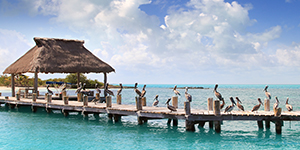
Loreto is a fabulous eco-tourist destination nestled between the clear blue Sea of Cortez and the towering Sierra de la Giganta. You can experience the Sea of Cortez within the protected waters of the Loreto Bay Marine Park, where you can kayak, swim, snorkel, scuba dive, fish, take an island tour, bird watch, and observe whales and dolphins. The Loreto Bay Marine Park is part of the World Heritage Alliance Site of the Islands in the Gulf of California.

Within a few miles of Loreto, you can explore the rugged peaks and canyons of the Sierra de la Giganta and visit the famous San Javier Mission, hike, ride horses and mules, and see centuries-old cave paintings. Right in the center of town you can visit Our Lady of Loreto Mission and its Spanish-era Museum, take a stroll along the Malecon, and bird watch in the sanctuary. Loreto is a historical pueblo of real Mexican charm and hospitality.

Loreto has been a world-class sports fishing destination since the mid-1960s, and anglers from all over the world come for the Dorado, Pacific Sailfish, Marlin, and Yellowtail. Whale watching has become increasingly popular and we see a high concentration of Blue Whales during winter and spring months. Other whales in the area are Humpback, California Grey, Fin, Minke, Sperm, and Orca. Loreto is headquarters as well for other once-in-a-lifetime eco-tourist adventures, including horse- and mule-packing trips, local and long-range kayaking, scuba diving, snorkeling, sailing, hiking, bird watching, and exploring our abundant natural wonders on both land and sea.
Loreto also has much for the culture and history enthusiast; this is where the first successful European settlement in “the Californias” was established. Padre Juan Maria Salvatierra landed at Loreto in late October 1697, and the Mission he founded became the center of the Jesuit effort to Christianize the indigenous peninsular people. Later on the Franciscans and then Dominicans continued the expansion of this system for nearly 1000 miles north via the El Camino Real.

Located on the Eastern side of the Baja California peninsula on the Sea of Cortez, named “the aquarium of the world” by the late Jacques Costeau. The dramatic Sierra de la Giganta mountain range west of Loreto consists of irregularly shaped volcanic peaks as high as 1,520 meters which plunge dramatically into the Sea of Cortez. The native Californian people said that Loreto is “where the mountains come to swim” and painted many representations of marine and terrestrial life in caves and on rock faces.
Rainfall is generally limited to late summer and associated with tropical storms and cyclones. Precipitation is more common in the higher elevations where dry river beds channel water that flows into the Sea of Cortez carrying vital nutrients. Loreto is located over 150 miles North of the mouth of the Sea of Cortez, well away from the tidal influence and waves action of the Pacific Ocean. Due to the calm seas, shorelines are rocky to pebbly broken up with mountainous terrain and a few isolated sandy beaches.

Due to its isolation, arid climate, and varied terrain, the Baja California peninsula has evolved some curiously photogenic plants and inland landscapes. Large cacti such as the Giant Cardon and the Pitahaya Dulce are well represented around Loreto as are hardwood trees such as the Mesquite. There is an endless number of canyons to be explored that ascend into rugged mountains. Erosion exposed rock yields fossilized seashells well above sea level overlooking the Islands that float in the deep blue Sea of Cortez, recognized for their natural beauty and biological diversity as a UNESCO World Heritage site. The Bay of Loreto National Marine Park was established in 1997 in recognition of our surrounding water’s natural beauty and abundance of marine life.
At night, on the sea, on the islands, in the mountains or out of town in the desert, an endless sea of stars blankets the city. In this setting peace and adventure are found.
www.loreto.com
www.ecoalianzaloreto.org
www.bcsbirds.com
www.cobi.org.mx/en


